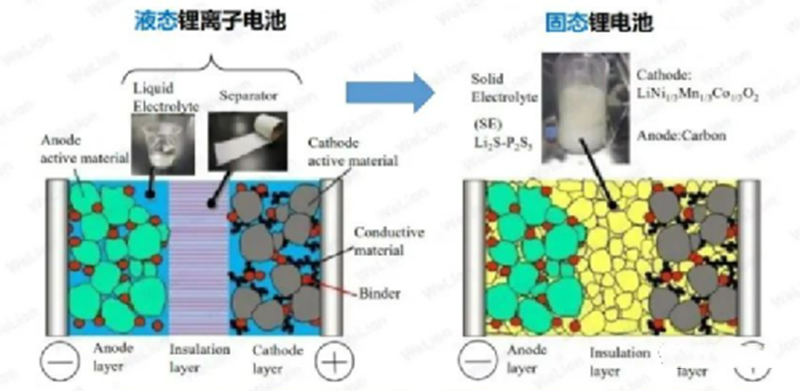-
Call Us
0086-592-7161550 -
Email us
ping@aotbattery.com -
Skype
ping@aotbattery.com
Call Us
0086-592-7161550Email us
ping@aotbattery.comSkype
ping@aotbattery.com
1. Energy density; Since the density of solid is higher than that of liquid, if the same volume of solid electrolyte is used to replace the lithium battery electrolyte, the weight of the battery will increase, resulting in a decrease in the energy density (wh/kg) of the battery calculated by weight.
The energy density of subsequent solid-state batteries will be significantly improved due to the use of new positive and negative lithium battery electrode materials. With the application of new materials such as metallic lithium, layered lithium-rich manganese, and sulfide cathodes, the energy density of solid-state batteries will significantly exceed the upper limit of 300wh/kg energy density of liquid batteries.
2. Safety: Semi-solid/all-solid batteries use solid-state electrolytes, which are significantly safer than liquid batteries, and all-solid-state batteries are safer.
1) In terms of lithium dendrites, the solid electrolyte can inhibit the growth rate of lithium dendrites, and it is difficult for lithium dendrites to penetrate the solid electrolyte and cause a short circuit between the positive and negative electrodes;
2) In terms of flammability, the ignition point of the solid electrolyte is higher than that of the electrolyte, and the battery is not easy to catch fire;
3) In terms of thermal stability, the heat resistance limit of solid electrolytes with different components varies greatly (ranging from 400 degrees to 1800 degrees), but they are all significantly higher than the heat resistance limit of liquid battery separators (160 degrees). Semi-solid batteries are slightly less safe than all-solid batteries because they retain a small amount of electrolyte, but they are still significantly better than liquid batteries.

3.Performance: Due to the poor conductivity of the solid-state electrolyte and the poor contact between the electrode and the electrolyte interface, the all-solid-state battery has a large internal resistance, poor cycle performance and rate performance. The performance of semi-solid batteries is slightly better than that of solid-state batteries due to the retention of electrolyte. 1) In terms of conductivity, the conductivity of existing solid electrolytes (ie lithium ion migration rate) is 1-2 orders of magnitude lower than that of liquid electrolytes, and the low conductivity leads to large internal resistance of the battery.
2) In terms of interface contact, solid-state batteries face the problem of solid-solid interface contact: the electrode material will expand and shrink with the charging and discharging process, and the liquid battery can maintain stable contact for a long time because the electrode material is soaked in the electrolyte;
The solid-state battery expands and contracts with the positive and negative electrodes, and it is easy to create gaps with the electrolyte particles, resulting in poor interface contact. Long-term charging cycles will increase the possibility of solid electrolyte rupture or separation from the electrodes. Semi-solid batteries can partially compensate for the problems of low conductivity and poor interface contact due to the retention of a small amount of electrolyte.
4.Other technical issues: lithium dendrites may break off, leading to "dead lithium" and reducing battery capacity; metal lithium appears porous during cycling, and its volume expands infinitely.
5.Cost: The cost of the electrolyte is significantly higher than that of the existing electrolyte, which significantly increases the cost of semi-solid/solid batteries.

Tel/Whatsapp: 0086-592-7161550

Scan to wechat:
